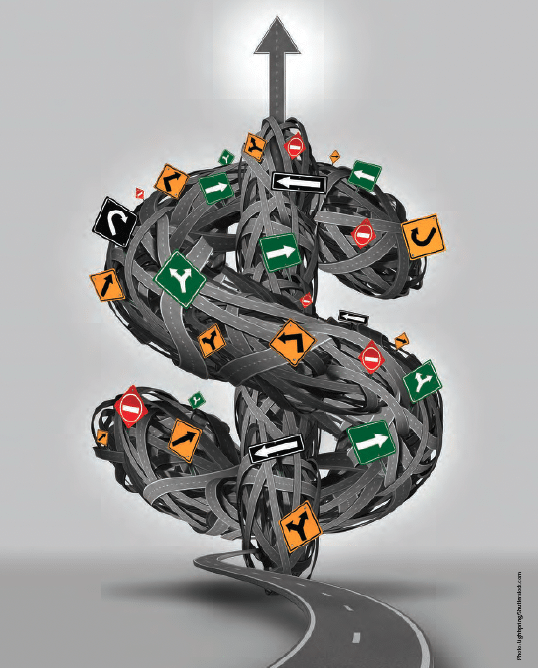The Road Ahead
For organizations facing unprecedented financial uncertainty, a strategy built around scenario planning can help clarify the options and make hard decisions less daunting.

In early March, presenters across the country began making fraught, often agonizing decisions about their upcoming programming. Information about the novel coronavirus and its appearance in major cities across the U.S. was evolving almost hourly, and choices had to be made quickly and often under great duress. Musicians, audiences, and staff in turn watched with a cycle of disbelief, panic, and resignation as their calendars emptied out: first through March, then the remainder of the season, then through the summer, and—for many—far beyond.
Running an arts organization has never been easy. Even under ideal circumstances, the finances are tough, the competition fierce, and the pace of change unceasingly rapid. For many in the chamber music field, much of the last two decades felt like an unceasing barrage of challenges. Add a once-in-a-lifetime pandemic to the mix, and many are understandably fearing the worst.
But beyond the direct impact of the pandemic itself, arts administrators are now burdened with another unprecedented challenge: almost total uncertainty about the future. For organizations used to planning their activities months or years in advance, it can feel like the entire playbook has been thrown out. How, so many have asked, can we plan when we know so little?
It goes without saying that there is no single, one-size-fits all solution to the challenges facing our field. But there are, however, certain tools that can help guide organizations toward the most informed, well-reasoned choices possible.
In April 2020, the Wallace Foundation convened nonprofit financial experts from Fiscal Management Associates (FMA) to offer a framework through which leaders might think through these decisions, with recommendations for areas of focus and tools to clarify available options. Their advice: take stock of your pre-Covid financial position, identify a set of likely scenarios for the future, and take action accordingly. Below, we’ve summarized FMA’s recommendations:
1. Understand Your Pre-Covid Financial Position
“In financial planning, what we aim to do is start with what we know, make certain assumptions, and then manage toward those assumptions,” says Hilda Polanco, founder and CEO of FMA. In order to devise a strategy for the future, you’ll need to first take inventory of your current financial situation. FMA emphasizes that it’s best to look at the immediate past, rather than the entirety of your most recent audit, even if that’s how your organization typically reviews its finances.
Start by getting a clear picture of your net assets. Begin with your unrestricted funds—FMA uses the term Liquid Unrestricted Net Assets (LUNA) here—as well as those with board designations. If the latter are designated as “rainy day funds,” you may decide that this is such an instance; if funds are designated for another specific purpose, speak with your board members about their willingness to redirect them.
You can then move on to assets with donor restrictions. “We’ve read nationally that many funders have been willing to relax their expectations around deliverables, accelerate payments, and revisit project grants into unrestricted grants,” says Polanco. Reach out to your funders and gauge their willingness to defer deliverables or otherwise make these funds available for earlier use, and determine if the spending rate of your endowment needs to be adjusted based on changes in the market. The goal here is to conserve your current net assets for use in the future.
2. Identify Implications and Scenarios
Once you have a clear picture of your pre-Covid financial situation, you can begin mapping out possible scenarios and their implications. Here, you’ll want to focus on three areas: Revenue, Expenses, and Financing.
“Scenario planning is not about getting it perfectly right,” Polanco says. “It’s about identifying choices on the road ahead that are distinctly different and that are going to be uniquely identifiable, because you’ve defined what the indicators are for each of these scenarios.” Indicators might include quantifiable changes in the market and reopening timelines in your community. You’ll want to identify clear “trigger points” corresponding to Best, Moderate, and Worst-Case scenarios, so there’s no ambiguity. Once you’ve established these scenarios and their indicators, you can proceed to planning how you’ll respond to each.
[sidebar, inset nearby if possible] Scenario Planning Tool
Available for free on strongnonprofits.org, the Revenue Scenario Planning Tool offers a helpful framework for mapping out different financial scenarios for each of your programs, with three tiers of revenue assumptions (Best Case, Moderate Case, Worst Case). Try it yourself by clicking the link at www.chamber-music.org/extras.
Revenue
By now, many organizations have applied for relief funding of one kind or another. It’s imperative that you do your research here: identify any opportunities that might still be available in your community or via the federal government, and pay close attention to deadlines. Emergency relief funding falls into two categories: loans and grants (also sometimes classified as forgivable loans).
Before you go any further, take the time to identify what FMA calls your Core Operations. In light of the pandemic, many organizations have significantly curtailed elements of their programming. Use this time to ask yourself what really defines your organization’s work, even if doing so necessitates hard conversations. Polanco puts it this way: “In the event that you cannot continue in all of your programming, which is the core that you will be raising or redirecting dollars for?”
Identifying your core operations will also help clarify where to start conversations with funders. “While I know that community is here to support organizations,” Polanco says, “those long time partners that you’ve developed over the years—be it government or private philanthropy—those are the conversations that you want to start with; with people that believe in the work and really are in a concerted effort to save the work.”
You’ll then want to look at the full picture of your revenue. This includes Contributed Revenue, covering individual donations, foundation and corporate funds, special events, and in-kind donations; and Earned Revenue, including program service fees, endowment income, government funds, and other miscellaneous items.
Take a close look at each budget line, and look for ways that funds might be repurposed. If you’ve cancelled events, for example, check to see if any sponsorship funds might be transitioned to donations. “I’ve seen organizations do amazing work in revisiting those sponsorships,” says Polanco. “Most sources I’ve seen are willing to redirect sponsorship dollars or registration fees to donations for the organization.” Or: if you’re in the process of devising new digital offerings or socially-distanced events, see if funds might be diverted to those projects.
Expenses
Expense drivers fall into three main categories: Workforce, Occupancy, and other Goods & Services. For most organizations, workforce will be by far the largest category. Occupancy entails rent, utilities, and carrying costs. For many, these assets are currently idle; for some others, physical locations may have already been repurposed to offer other services to the community. It’s worth considering whether such a repurposing is possible in your case, in order to minimize carrying costs.
From there, it helps to further divide your expenses into three other categories: Fixed, Variable, and Semi-Variable. Fixed expense might include things like rent and utilities; Variable and Semi-Variable costs fluctuate as programs are expanded or downsized (the latter might include utilities that vary with program activity, for example).
When assessing workforce expenses, salaries and associated benefits are the obvious starting point. However, you should also be sure to account for accruals that could become liabilities, in the event of lay-offs. This includes accrued paid time off (PTO) and federally mandated sick leave, the latter of which has been expanded under the CARES Act.
Here, again, hard conversations may be a part of the process. It goes without saying that lay-offs are an outcome everyone wants to avoid, if at all possible. As alternatives, consider re-shaping or consolidating positions, furloughs, and/or restructuring full-time positions to part-time, with consideration of any implications to benefits eligibility. “This is a moment where I encourage you to seek legal advice,” says Polanco. “Some funders have had law firms provide pro bono, or your board members may have advisers.”
FMA also urges organizations to think about how their values intersect with difficult staffing decisions. “When you make these choices, think about an equity perspective,” Polanco says. “This is all part of the same organization, staff, and community that you’ve been supporting throughout the years.”
Finally, take time to consider what staffing you’ll need on “the other side”—even if the timeline for reaching such a place remains murky. You may again find it helpful here to give further thought to your core operations. Ask yourself: what do we need to preserve in order to maintain our core identity?
Cash Flow & Financing
In the next months, it will be integral to keep a close eye on your cash flow, ideally maintaining and updating projections at three regular time intervals: weekly, monthly, and quarterly. In order to bridge the gap during revenue shortfalls, consider approaching vendors and partners to revisit payment terms; delaying any non-essential payments; settling up accounts receivable; and approaching funders about their willingness to accelerate grant payments.
[sidebar, inset nearby if possible] Cash Flow Planning Tool
Also available for free on strongnonprofits.org, the Cash Flow Planning Tool is designed to help organizations plot their cash flow over time. (Polanco refers to this tool as a “navigation device for executive directors.”) Try it yourself by clicking the link at www.chamber-music.org/extras.
In terms of financing, FMA urges a conservative approach: “We want to apply for a credit line when we don’t need it, and we want to manage that credit line to serve as a flotation device, and not as a source of financing an operating deficit,” Polanco explains. In other words, you should always “know how those dollars are going be repaid.” The current environment is a challenging time to apply for a new line of credit, as doing so typically requires that you submit evidence of the financial health of your organization. However, if you have a strong existing relationship with a bank, it may be a workable solution.
3. Take Action
As you begin to establish a set of scenarios and a plan for each, it’s important that you continually engage the appropriate members of leadership in your organization, including those who manage your programs, development, hiring (if applicable), and—last but certainly not least—finances. These are the people who will be closest to both the execution and impact of the actions you take.
In your communications with your board, try to build in flexibility: the data will continue to change, and a mode of nimble adaptation is best. “We’re really redefining the concept of a timeline,” says Polanco. “Budgeting and planning are not business as usual right now.” This is where the value of scenario planning once again comes in: develop those Best, Moderate, and Worst-Case scenarios, with established trigger points, so that you can react quickly as the data change.
Finally, continue communicating, across multiple channels, with everyone impacted by your actions. Their feedback will remain invaluable as you move forward.
For more resources, including the original webinar on which this article is based, visit www.wallacefoundation.org.

